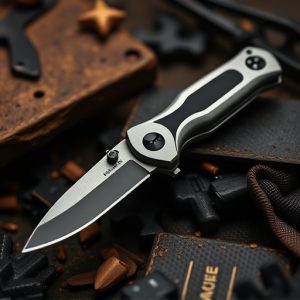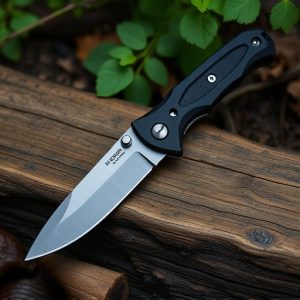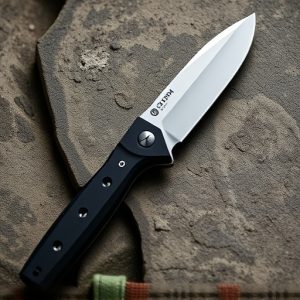Mastering OTF Automatics: A Guide to Mechanisms, Laws, and Safe Use
The OTF (One-Time-Fly) automatic knife is a specialized pocketknife with a unique single-button dep…….
The OTF (One-Time-Fly) automatic knife is a specialized pocketknife with a unique single-button deployment mechanism that extends the blade smoothly and reliably thanks to precise internal springs and pivoting wrist components. These knives are not only a blend of form and function but also a hit among collectors and everyday users for their innovative design, practicality, and aesthetic appeal. Users must be aware of both the legal restrictions and safety protocols due to their automated functionality, with laws varying by jurisdiction within the United States. It's crucial to adhere to responsible handling practices and comply with regulations like the Federal Switchblade Act of 1958 and additional state and local laws. Maintenance is key for the knife's longevity and safety, with features like assisted opening, safety locks, and various blade styles enhancing their utility for self-defense, tactical operations, hunting, survival, and everyday carry. OTF automatic knives are constructed from high-quality materials like stainless steel, ensuring durability and performance. Prospective owners should engage in educational programs to understand the legal complexities and safe use of these devices, emphasizing the importance of safety and legality over practicality alone.
Explore the intricacies, mechanics, and legal dimensions of owning and operating an OTF automatic knife with our meticulously crafted guide. This article demystifies the workings of these precision instruments and provides insights into their functions. Whether for collectors or professionals, understanding the nuances of OTF automatic knives is paramount for responsible ownership and safe use. Join us as we delve into the world of OTF automatic knives, ensuring you’re well-informed on every aspect from a technical to a legal perspective.
Understanding OTF Automatic Knives: A Comprehensive Guide
Otdel’nye tseli perezapinyаtaющikhся (OTF) or automatic knives represent a unique and efficient class of pocketknives that deploy with a single press of a button. These devices are engineered with precision mechanisms, allowing the blade to extend from its handle swiftly and reliably. The OTF automatic knife is distinct in its deployment method compared to traditional sliding or folding pocketknives, as it uses internal springs and a pivoting wrist structure. The blade emerges from the front of the handle, creating a sleek design that’s both practical and visually appealing.
When considering an OTF automatic knife for your collection or everyday carry, it’s crucial to understand the legal implications and safety considerations associated with such a device. These knives are subject to various regulations, and it’s imperative to be aware of the laws in your jurisdiction before purchasing or carrying one. Additionally, due to the automatic nature of these knives, they require responsible handling to prevent accidental deployment. Users should familiarize themselves with proper maintenance and operational protocols to ensure longevity and safety. The OTF automatic knife’s seamless integration of form and function, coupled with its unique deployment system, makes it a coveted item for collectors and users alike, provided it is handled with the appropriate care and understanding of its role in various applications.
The Mechanics and Functions of OTF Automatic Knives
Otdelnik trudnosotnykh vozdušnykh komandных (OTF) or automatic knives represent a marvel of engineering and design, combining speed and efficiency for quick deployment in a variety of situations. The mechanics behind an OTF automatic knife are sophisticated, involving a series of internal components that work in concert to facilitate its operation. Upon activation, typically by twisting a grip or pressing a button, the knife’s blade extends automatically from its handle due to a compressed spring or gas pressure system. This spring-loaded mechanism is housed within the handle and is tensioned at a precise force to ensure the blade deploys smoothly and with sufficient impact to break through resistances. The blade’s exit is usually signaled by an audible ‘click’ and a visual locking indicator, ensuring the user that the knife is in its full, operational state. The functions of OTF automatic knives are diverse; they can be used for self-defense, tactical operations, hunting, survival situations, and everyday carry. The blade, often made from high-quality stainless steel or other durable materials, is designed to be sharp, resistant to corrosion, and capable of withstanding significant wear and tear. The handle, ergonomically crafted, provides a firm grip and control even when hands are wet or under stress. Additionally, many OTF automatic knives come with additional features such as assisted opening, safety locks, and varying blade styles to suit different tasks, making them indispensable tools for those who require a reliable cutting instrument at a moment’s notice.
Legal Considerations and Responsible Ownership of OTF Automatic Knives
When considering the legal framework surrounding OTF (One-Time-Flash) automatic knives, it’s imperative to understand that their legality varies by jurisdiction. In the United States, for instance, the Federal Switchblade Act of 1958 regulates these devices under certain conditions. Owners must be aware of state and local laws, as they often dictate more stringent regulations than federal statutes. Responsible ownership begins with a thorough comprehension of the applicable laws, which typically require individuals to be of legal age to purchase and carry such knives. Additionally, there may be restrictions on where these knives can be carried or whether open carrying is permitted.
For those who choose to own an OTF automatic knife, adhering to responsible ownership practices is paramount. This includes securing the knife when not in use to prevent unauthorized access by children or others who should not have access to it. Proper maintenance and handling ensure the knife operates safely, reducing the risk of accidental deployment or injury. Educational programs and safety courses can further inform potential owners about the responsible use and legal implications of owning an OTF automatic knife. It’s crucial to prioritize safety and legality above all else when incorporating these specialized tools into one’s collection or everyday carry.


